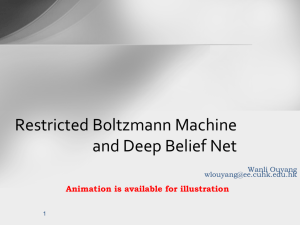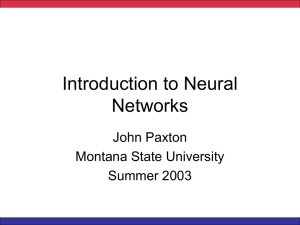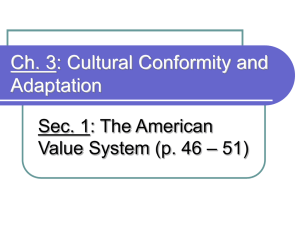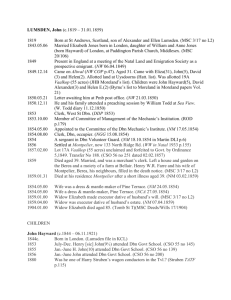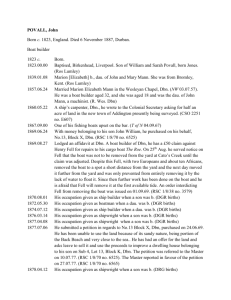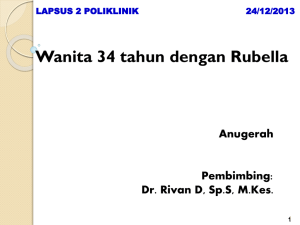Deep Learning
advertisement
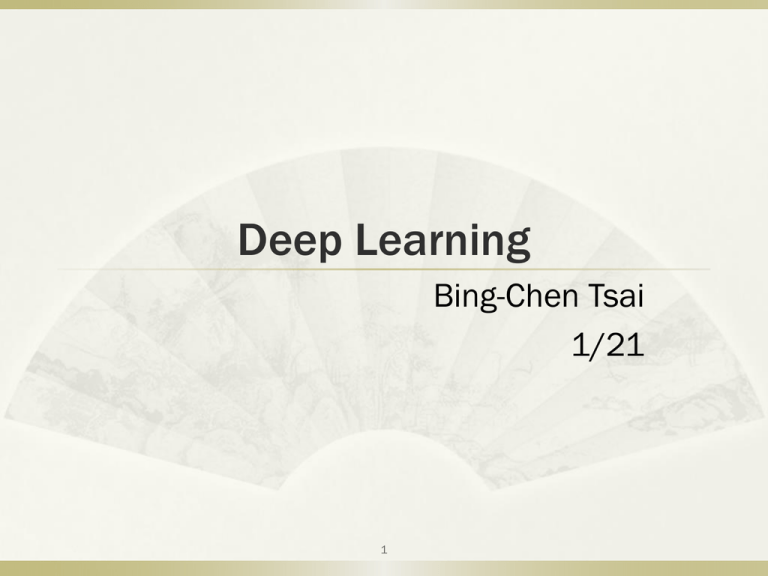
Deep Learning Bing-Chen Tsai 1/21 1 outline Neural networks Graphical model Belief nets Boltzmann machine DBN Reference 2 Neural networks Supervised learning The training data consists of input information with their corresponding output information. Unsupervised learning The training data consists of input information without their corresponding output information. 3 Neural networks Generative model Model the distribution of input as well as output ,P(x , y) Discriminative model Model the posterior probabilities ,P(y | x) P(x,y1) P(x,y2) P(y1|x) 4 P(y2|x) Neural networks x1 What is the neural? Linear neurons y b x i w i x2 w1 w2 1 b y i Binary threshold neurons z = b + å xi wi y 0 otherwise i Sigmoid neurons z b x i w i 1 y i 1 Stochastic binary neurons z b i 5 1 if z³0 e xi wi z 1 p ( y 1) 1 e z Neural networks Two layer neural networks (Sigmoid neurons) Back-propagation Step1: Randomly initial weight Determine the output vector Step2: Evaluating the gradient of an error function Step3: Adjusting weight, Repeat The step1,2,3 until error enough low 6 Neural networks Back-propagation is not good for deep learning It requires labeled training data. Almost data is unlabeled. The learning time is very slow in networks with multiple hidden layers. It is very slow in networks with multi hidden layer. It can get stuck in poor local optima. For deep nets they are far from optimal. Learn P(input) not P(output | input) What kind of generative model should we learn? 7 outline Neural networks Graphical model Belief nets Boltzmann machine DBN Reference 8 Graphical model A graphical model is a probabilistic model for which graph denotes the conditional dependence structure between random variables probabilistic model In this example: D depends on A, D depends on B, D depends on C, C depends on B, and C depends on D. 9 Graphical model A Directed graphical model 𝑃 𝐴, 𝐵, 𝐶, 𝐷 = 𝑃 𝐴 𝑃 𝐵 𝐴 𝑃 𝐶 𝐴 𝑃(𝐷|𝐵, 𝐶) B C D Undirected graphical model 𝑃 𝐴, 𝐵, 𝐶, 𝐷 = A C B D 1 ∗ φ 𝐴, 𝐵, 𝐶 ∗ 𝜑(𝐵, 𝐶, 𝐷) 𝑍 10 outline Neural networks Graphical model Belief nets Boltzmann machine DBN Reference 11 Belief nets A belief net is a directed acyclic graph composed of stochastic variables stochastic hidden causes Stochastic binary neurons z b i xi wi 1 p ( y 1) 1 e z It is sigmoid belief nets visible 12 Belief nets we would like to solve two problems The inference problem: Infer the states of the unobserved variables. The learning problem: Adjust the interactions between variables to make the network more likely to generate the training data. stochastic hidden causes visible 13 Belief nets It is easy to generate sample P(v | h) It is hard to infer P(h | v) stochastic hidden causes Explaining away visible 14 Belief nets Explaining away H1 H2 H1 and H2 are independent, but they can become dependent when we observe an effect that they can both influence 𝑃 𝐻1 𝑉 𝑎𝑛𝑑 𝑃 𝐻2 𝑉 𝑎𝑟𝑒 𝑑𝑒𝑝𝑒𝑛𝑑𝑒𝑛𝑡 V 15 Belief nets Some methods for learning deep belief nets Monte Carlo methods But its painfully slow for large, deep belief nets Learning with samples from the wrong distribution Use Restricted Boltzmann Machines 16 outline Neural networks Graphical model Belief nets Boltzmann machine DBN Reference 17 Boltzmann Machine It is a Undirected graphical model The Energy of a joint configuration hidden j i -E(v, h) = å vibi + iÎvis p(v, h) = e å kÎhid -E(v, h) å e-E(u, g) hk bk + å vi v j wij + å vi hk wik + å hk hl wkl i< j i, k e-E(v, h) å h p(v) = åu, g e-E(u, g) u, g 18 k<l visible Boltzmann Machine v h -E e-E p(v, h ) p(v) An example of how weights define a distribution h1 +2 v1 19 -1 h2 +1 v2 Boltzmann Machine A very surprising fact ¶log p(v) = si s j ¶wij Derivative of log probability of one training vector, v under the model. v - si s j Expected value of product of states at thermal equilibrium when v is clamped on the visible units Dwij µ si s j data 20 - si s j model Expected value of product of states at thermal equilibrium with no clamping model Boltzmann Machines Restricted Boltzmann Machine We restrict the connectivity to make learning easier. Only one layer of hidden units. We will deal with more layers later No connections between hidden units Making the updates more parallel visible 21 Boltzmann Machines the Boltzmann machine learning algorithm for an RBM j j j <vi h j>¥ <vi h j>0 i t=0 j i i t=1 i t=2 Dwij = e ( <vi h j >0 - <vi h j>¥ ) 22 t = infinity Boltzmann Machines Contrastive divergence: A very surprising short-cut j <vi h j>0 i t=0 data j <vi h j>1 This is not following the gradient of the log likelihood. But it works well. i t=1 reconstruction Dwij = e ( <vi h j >0 - <vi h j>1 ) 23 outline Neural networks Graphical model Belief nets Boltzmann machine DBN Reference 24 DBN It is easy to generate sample P(v | h) It is hard to infer P(h | v) stochastic hidden causes Explaining away visible Use RBM to initial weight can get good optimal 25 DBN Combining two RBMs to make a DBN Then train this RBM h2 W2 h1 Compose the two RBM models to make a single DBN model W2 h1 copy binary state for each v W1 h1 Train this RBM first h2 v W1 It’s a deep belief nets! v 26 DBN etc. W T h2 Why we can use RBM to initial belief nets weights? An infinite sigmoid belief net that is equivalent to an RBM W v2 W T h1 Inference in a directed net with replicated weights Inference is trivial. We just multiply v0 by W transpose. The model above h0 implements a complementary prior. Multiplying v0 by W transpose gives the product of the likelihood term and the prior term. W v1 W h0 W v0 27 T DBN Complementary prior X1 X2 X3 X4 A Markov chain is a sequence of variables X1;X2; : : : with the Markov property 𝑃 𝑋𝑡 𝑋1 , … , 𝑋𝑡−1 = 𝑃(𝑋𝑡 |𝑋𝑡−1 ) A Markov chain is stationary if the transition probabilities do not depend on time 𝑃 𝑋𝑡 = 𝑥 ′ 𝑋𝑡−1 = 𝑥 = 𝑇 𝑥 → 𝑥 ′ 𝑇(𝑥 → 𝑥′) is called the transition matrix. If a Markov chain is ergodic it has a unique equilibrium distribution 𝑃𝑡 𝑋𝑡 = 𝑥 → 𝑃∞ 𝑋 = 𝑥 𝑎𝑠 𝑡 → ∞ 28 DBN Most Markov chains used in practice satisfy detailed balance 𝑃∞ (𝑋)𝑇(𝑋 → 𝑋′) = 𝑃∞ (𝑋′)𝑇(𝑋′ → 𝑋) e.g. Gibbs, Metropolis-Hastings, slice sampling. . . Such Markov chains are reversible X1 X2 X3 X4 𝑃∞ 𝑋1 𝑇 𝑋1 → 𝑋2 𝑇 𝑋2 → 𝑋3 𝑇(𝑋3 → 𝑋4 ) X1 X2 X3 X4 𝑇 𝑋1 ← 𝑋2 𝑇 𝑋2 ← 𝑋3 𝑇 𝑋3 ← 𝑋4 𝑃∞ (𝑋4 ) 29 DBN 𝑃 𝑌𝑘 = 1 𝑋𝑘+1 = 𝜎(𝑊 𝑇 𝑋𝑘+1 + 𝑐) 𝑃 𝑋𝑘 = 1 𝑌𝑘 = 𝜎(𝑊𝑌𝑘 + 𝑏) 30 DBN Combining two RBMs to make a DBN Then train this RBM h2 W2 h1 Compose the two RBM models to make a single DBN model W2 h1 copy binary state for each v W1 h1 Train this RBM first h2 v W1 It’s a deep belief nets! v 31 Reference Deep Belief Nets,2007 NIPS tutorial , G . Hinton https://class.coursera.org/neuralnets-2012001/class/index Machine learning 上課講義 http://en.wikipedia.org/wiki/Graphical_mod el 32


